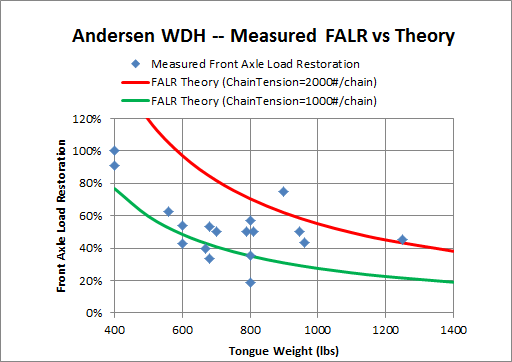ChrisGNV wrote:
---I'll be towing a 4,500# trailer with a Durango Hemi (2005, truck frame) and putting about 500# on the hitch. I'd like to move as much of that to the front as was shifted back by connecting the trailer. If it won't do that sufficiently, I'll have to consider a more traditional rig.
Is 4500# the expected loaded weight of the trailer or is it the empty weight?
If the loaded weight is 4500#, the tongue weight should be about 4500*0.13 = about 600# for good yaw stability.
If 4500# is the "dry weight", then you could be looking at a loaded weight of 6000# and a loaded TW of nearly 800#.
I take your statement about moving load to the front to mean that you'd like to restore 100% of the load which was removed from the front axle.
Based on Andersen user reports, if 100% front axle load restoration (FALR) is your goal, it is not likely you will be able to achieve that with the Andersen WDH and a 600-800# TW.
The following is a plot of FALR values versus tongue weight derived from load transfer information provided by Andersen users.
The data suggest that with a 600-800# TW, you might be limited to a FALR of 60% or less.

Front Axle Load Restoration (FALR) is chosen as the indicator of load transfer effectiveness.
For measured front-axle loads, FALR is defined as the amount of load added by application of WD divided by the amount of load removed by tongue weight (with NO WD applied).
For measured front-axle heights, FALR is defined as the front-end lowering due to application of WD divided by the front-end rise due to tongue weight (with NO WD applied).
When the front end is observed to be returned to the unhitched height, the FALR is taken to be 100%.
The data indicate FALR=100% can easily be achieved for low tongue weights.
However, for tongue weights in excess of 1000#, it is not clear that FALR=100% can be achieved.
The curves labeled "FALR Theory" are calculated from:
FALR = 100*CT*2*LA*(1+BOH/TTL)/TW/BOH where CT = chain tension in #/chain LA = lever arm from ball center to chain in ft (assumed to be 6.5"/12 per Bruce H.)
BOH = ball overhang in ft (assumed to be 5') TW = tongue weight in lbs TTL = distance from ball to mid-point between axles (assumed to vary from 12' for TW=400# to 20' for TW=1200#)
Contributors of data can be identifed by their TW and achieved FALR in the following table:
TW - FALR - Load/Height - Contributor - DataSource
400---100%----hgt.----SteveH------Airforums.com
400----91%----load----Bruce H.-----Lanceowners.com, RV.net, Airforums.com
900----75%----hgt.----gallifrey------RV.net
800----57%----load----airheadsrus---Airforums.com (updated for 10 threads)
600----54%----load----hbillsmith-----RV.net
800----50%----load----airheadsrus---Airforums.com
800----36%----load----airheadsrus---Airforums.com (new data for 9 threads)
1250---45%----load----housedad-----RV.net 960----43%----load----renojack------RV.net
600----43%----hgt.----zues----------Airforums.com
670----40%----load----HowieE-------Airforums.com
560----63%----load----eartha--------RV.net
800----19%----load----CHD Dad 3/16"--RV.net
800----50%----load----CHD Dad 7/16"--RV.net
946----50%----load----babies_dadeo---RV.net
680----33%----load----idroba--------Airforums.com
680----50%----load----idroba--------Airforums.com
700----50%----hgt.----PHS79-----------RV.net
(chart updated 11/16/2013)
Ron
